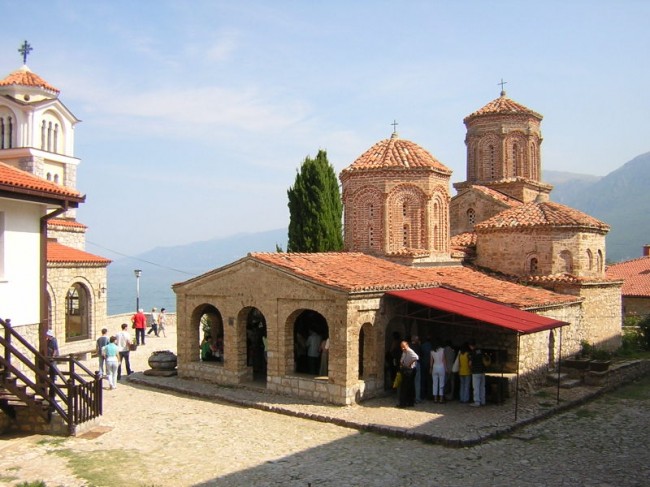An Orthodox monastery of the 10th century in FYROM (the so-called Republic of “Macedonia”) has been transformed to a hotel-spa and practices Hinduism
11 Δεκεμβρίου 2009
The monastery of St. Naum is located on the southeast side of Lake Ohrid, in the immediate vicinity of the FYROM-Albanian border. Its building is linked to the name of St. Naum, the closest associate of St. Clement of Ohrid. Records about the life and work of St. Naum can be found in three literature works dedicated to his life. Also the Archbishop of Ohrid, Constantine Cavassila, wrote about him. In the Historical Archives of Ohrid there is a Chronicle written by a priest that lived in the second half of XIX century. It reveals a series of interesting details about the construction of the monastery, the estate of the church, and the lives of the monks. Among other things, there is a record about a disastrous fire that occurred on the night of 2nd and 3rd February 1875, when the largest part of the monastery compound was burnt to ashes.
Towards the end of his life St. Naum of Ohrid built the monastery St. Archangel where he was buried in 910. The church of Naum was similar to the monastery of Clement, St. Pantheleimon, and was built in a trefoil shape.
In the course of the archaeological excavations carried out after the Second World War, only the foundations and part of the walls of that church were discovered. It is unknown when the church was ruined, but the assumption is that it happened before the arrival of the Turks.
During the Ottoman period (presumably XVI century), on the foundations of the original church the church that exists today was built in two phases. Today the church is cruciform in a square space with a dome supported by four pillars. A similar dome with a tall tambour was added onto the nartex. The tomb of St. Naum is located on the southern side, in a separate chamber.
In the church there are no preserved frescoes from the time of St. Naum, nor have the excavations prove that there were any paintings in the beginning of X century.
According to the inscriptions in the church, the frescoes were painted in the period of the priest Stefan, in 1806. They were painted by the fresco artist Trpo, son of the Master Constantine from Korcha, Albania.
Particularly impressive are the scenes from the life and miracles of St. Naum of Ohrid. They were painted in he second zone of the chapel above Naum’s tomb. The five painted scenes were passed from one generation to another, and are deemed to be the miracles of Naum. These are: “Harnessing the Bear”, “The Stupefied Monk Who Tried to Steal the Body of Saint Naum From His Tomb”, “Healing of the Mentally Disturbed”, “Horse Thief Who Was Caught at the Gates of the Monastery Church at Dawn” and “The Bucket Leaves Traces in the Rock”. The belief that St. Naum was capable to heal the mentally disturbed predominates. According to some sources, a “hospital” was operating within the monastery in 1662.
The iconostasis in the church was carved in 1711. The authors are unknown. They were influenced by the woodcarving traditions of Mount Athos and they created a genuine masterpiece. During the same year the artist Constantine painted the dais and the holiday icons. Most outstanding are the icons “Crucifixion” and “Entrance into Jerusalem”. The icons of the iconostasis are treated as one of the best achievements from the first part of XVIII century.
Two Cyrillic and one glagolitic-cyrillic inscriptions dating from the period between the late X and XII centuries can be found on the pillars of the parvis. These inscriptions testify about the development of the oldest Slavic scripts, Glagolitic and Cyrillic, in the Ohrid region.
http://hotel-stnaum.com.mk/index-en.php
http://hotel-stnaum.com.mk/index-en.php?page=banja-sveti-naum




